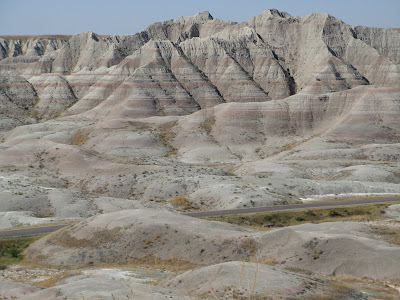Is not the sky a father and the earth a mother, and are not all living things with feet or wings or roots their children?
—Nicholas Black Elk, Lakota spiritual leader, 1932

The Lakota called this place mako sica. French trappers knew it as les mauvaises terres á traverser. Both have the same meaning: Bad Lands.
 We arrive at dusk, as has become our routine to enter the national parks, and we find a tragically beautiful place. It's eerie and ethereal, mystical and haunted by the sound of wind rustling the grasses and insects buzzing across desolate plains. We enter the park Sept. 16 with the sun setting beyond the colorful, banded wall, glowing in soft purple and orange hues. As the moon rises we drive the Badlands Loop and listen to American Indian songs while an owl glides over the prairie and a massive buck stands near the road. We see their earthly form but prefer to think of them as ancient spirits assuming animal shapes.
We arrive at dusk, as has become our routine to enter the national parks, and we find a tragically beautiful place. It's eerie and ethereal, mystical and haunted by the sound of wind rustling the grasses and insects buzzing across desolate plains. We enter the park Sept. 16 with the sun setting beyond the colorful, banded wall, glowing in soft purple and orange hues. As the moon rises we drive the Badlands Loop and listen to American Indian songs while an owl glides over the prairie and a massive buck stands near the road. We see their earthly form but prefer to think of them as ancient spirits assuming animal shapes.After setting up camp, we take Ophie to the amphitheater for the ranger's nightly program. Tonight's toipc: Prairie, which once sprawled across one-third of North America. Only 2 percent remains.

Badlands contains mixed-grass prairie, tall-grass species including big bluestem and prairie cordgrass, and short-grasses such as blue grama and buffalo grass. Today, prairie dogs, muledeer, pronghorn, bison, coyotes, big-horn sheep and black-footed ferrets live and thrive in the park. We watch and listen to the ranger's presentation and appreciate the still, subtle beauty of the grassland, and gaze up at the stars covering the dark, moonless sky.


In the morning, we wake to the Western Meadow Lark's melodic birdsong. It's hot—88 degrees in this land of extremes—and our plans for an intense morning hike quickly fade. Instead, we take a fossil walk and see bygone creatures from millions of years ago like the Leptomeryx, a small, deer-like animal, sheep-like Oreodonts, ancient pigs called Archaeotherium, Mesohippus, a three-toed ancestor of modern horses, and Subhyracodon, a small, plant-eating rhinoceros.

Next stop: Big Foot Pass.
This is the place where Chief Big Foot led about 350 men, women and children down the Badlands Wall on Dec. 24, 1890. Five days later, nearly 200 of them were massacred at Wounded Knee, just to the south. It's an emotional place—much more so, I'm sure, for Lakota descendants.
Next time, we'll visit the Stronghold Table (we're driving the North Unit; it's in the South Unit, through rutted tracks and closed gates) and stand in the place where the Lakota men danced the Ghost Dance for the last time before Wounded Knee. We leave Badlands less than 24 hours after our arrival. But the pictures in our minds of Lakota families pushed across this hard, desolate landscape in the dead of winter—when we don't even want to leave the comfort of the air-conditioned truck to hike a few miles through the canyons—driven to their death haunts us still.
—Jessica




No comments:
Post a Comment